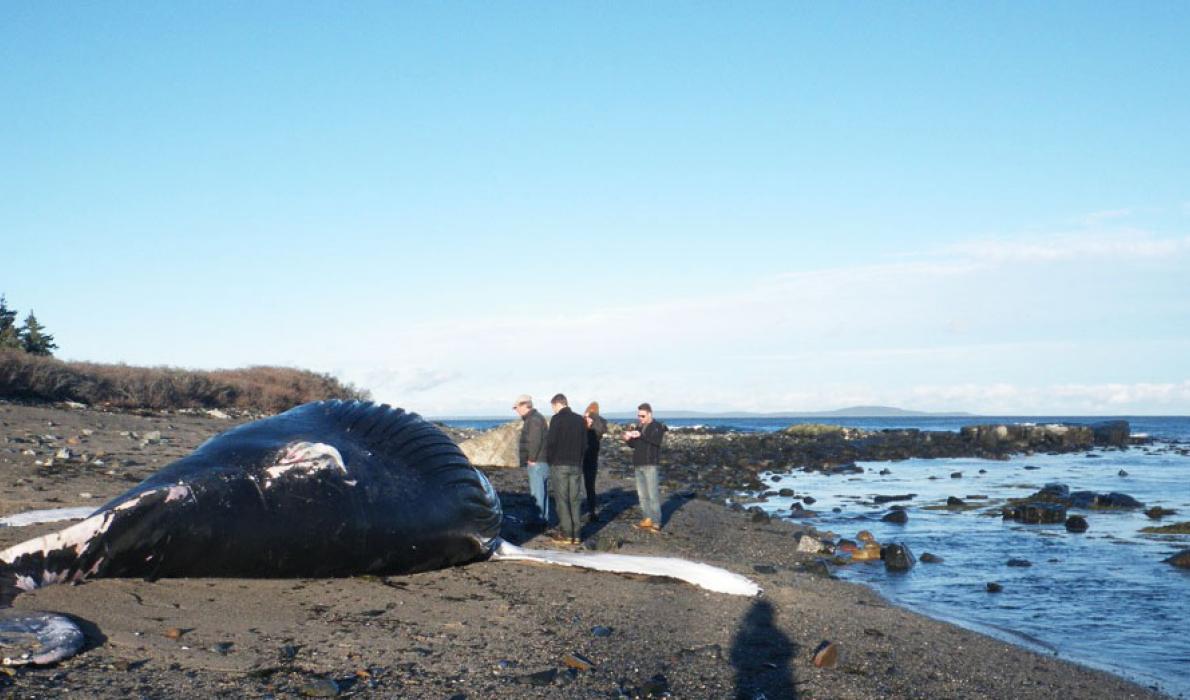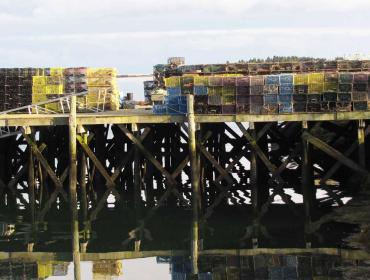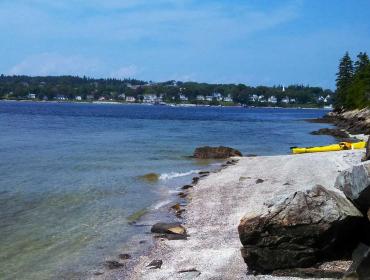Posted January 14, 2015
Last modified March 9, 2015
Christmas Day in the Cranberry Isles arrived with winds high enough to cause ferry cancelations, though the air temperature was unseasonably mild. Fortunately for us, our family had arrived two days earlier.
In a rare event that might occur once in five years, both of our sons came home to the island for Christmas at the same time. Cameron and his fiancée Anne were here from Portland, and Robin and his wife Stephanie were here from Baltimore. After consuming a late breakfast and exchanging gifts, five of us decided to go for a walk while Bruce stayed home to take a Christmas nap.
We walked the half-mile or so to the old Coast Guard Life Saving Station at the eastern end of the island, commenting on the unusual 50-degree temperature. As we stood on the lawn of the property that is now a private summer home, we looked east and witnessed a rare event of a different kind. A dead humpback whale was on the beach at the high tide mark, rocking ever so softly as the water started to recede.
It was the biggest creature any of us had ever seen.
The 35-foot whale inspired such a mix of feelings—sadness, awe, appreciation, wonder and relief to see no rope attached. Despite how fascinating it is to get such a close look at one of the ocean's most amazing creatures, the last thing any fisherman or his family wants to see is a dead whale. First of all, it's tragic, and secondly, fishermen fear condemnation before investigation when it comes to the cause of death.
Some people are all too quick to think a whale has died from entanglement in fishing gear without considering the other threats whales face from ship strikes, whale-watch harassment, and habitat impacts such as pollution, ocean acidification and negative effects from sonic tests done by the Navy.
We called Bruce who abruptly ended his nap to come and see the whale. He stopped to tell Stefanie and Rick Alley about it on his way down the road.
The next day Stefanie called to report it to Allied Whale, the marine mammal research group at College of the Atlantic (COA) in Bar Harbor. From photographs sent to the stranding coordinator at Allied Whale; Dr. Jooke Robbins of the Center for Coastal Studies in Provincetown, Mass.; and COA student Grace Shears, each independently recognized and identified the whale as "Triomphe," an almost 7-year old male. Knowing his name did not make accepting his death any easier.
On Dec. 29, a four-person stranding investigative team came out to the island to take measurements, photographs and tissue samples to send out for analysis. Two years ago when a small dead minke whale washed up on the south side of Islesford in June, Allied Whale was able to tow it away to study it and recover the skeleton. Many of us assumed this would be the case with Triomphe.
One of the members of the team was Tom Fernald, with whom Bruce communicated by email after they met on the dock. He asked if Allied Whale had plans to remove the humpback, or could we consider getting a few back-hoes to push the mammal off into the water with the next favorable high tide and calm sea.
The answer was "no" in both cases.
Allied Whale's director Sean Todd and stranding coordinator Rosie Seton were contacted, and Sean asked Bruce what his ideal outcome was for this whale, as they did not have NOAA funding take it on.
"As you can imagine as the animal starts to rot (which will be delayed a little by our current temperatures) the smell and gore can be quite unpleasant," Sean wrote in an email. "In such situations the town is responsible for carcass disposal, and it is probably better to act sooner rather than later."
Bruce forwarded the email to the town office so selectmen could discuss whale carcass disposal (which had not yet happened as of this column being posted, given cancelations due to weather).
Sean's email included various ways the town could deal with the rotting whale carcass including burial on site or cutting it up and hauling it away to be buried off-island or composted so the skeleton could be recovered. The suggestions were helpful. But they looked like they were going to cost the town money.
Bruce then heard that the whale carcass had left the beach on the high tide and high wind during the night, but it was now resting just west of the old Coast Guard station.
Mendy Garron, who oversees the regional marine mammal stranding program for NOAA Fisheries Service, contacted Bruce to report that since the humpback is an endangered species, "the response efforts and disposal of the carcass are authorized under a Scientific Research Permit granted to our program." I'm not sure if that means NOAA will help pay for the disposal, but at least our town will be well supported with professional advice on how to remedy this rare problem.
In the meantime, I'm keeping my fingers crossed that the 13-foot tides predicted for later this month will let Mother Nature solve the problem for us, giving Triompe a quiet burial at sea.

Contributed by




